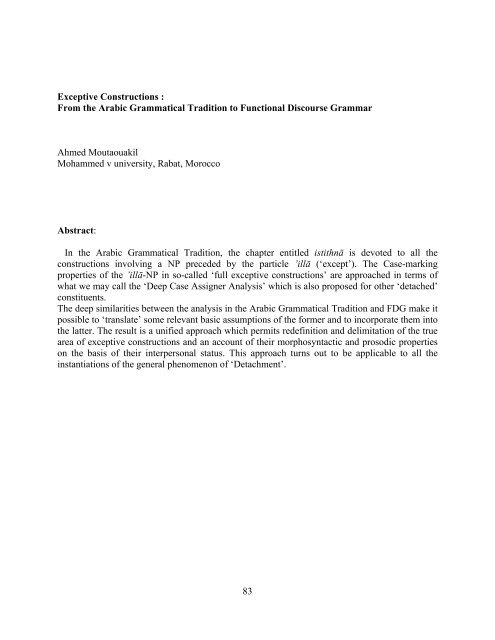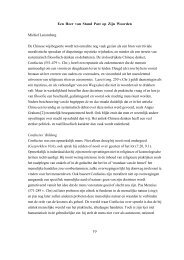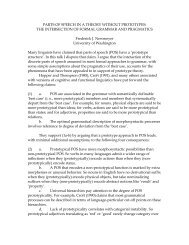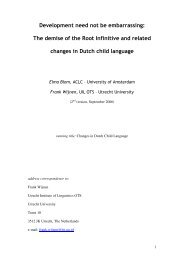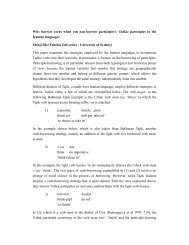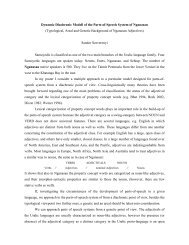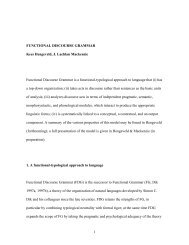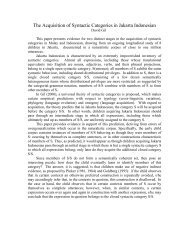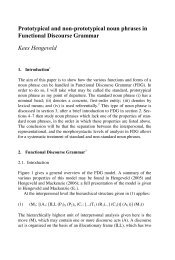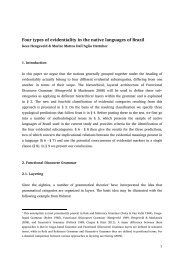From the Arabic Grammatical Tradition to Functional Discourse ...
From the Arabic Grammatical Tradition to Functional Discourse ...
From the Arabic Grammatical Tradition to Functional Discourse ...
You also want an ePaper? Increase the reach of your titles
YUMPU automatically turns print PDFs into web optimized ePapers that Google loves.
Exceptive Constructions :<br />
<strong>From</strong> <strong>the</strong> <strong>Arabic</strong> <strong>Grammatical</strong> <strong>Tradition</strong> <strong>to</strong> <strong>Functional</strong> <strong>Discourse</strong> Grammar<br />
Ahmed Moutaouakil<br />
Mohammed v university, Rabat, Morocco<br />
Abstract:<br />
In <strong>the</strong> <strong>Arabic</strong> <strong>Grammatical</strong> <strong>Tradition</strong>, <strong>the</strong> chapter entitled istithnā is devoted <strong>to</strong> all <strong>the</strong><br />
constructions involving a NP preceded by <strong>the</strong> particle ’illā (‘except’). The Case-marking<br />
properties of <strong>the</strong> ’illā-NP in so-called ‘full exceptive constructions’ are approached in terms of<br />
what we may call <strong>the</strong> ‘Deep Case Assigner Analysis’ which is also proposed for o<strong>the</strong>r ‘detached’<br />
constituents.<br />
The deep similarities between <strong>the</strong> analysis in <strong>the</strong> <strong>Arabic</strong> <strong>Grammatical</strong> <strong>Tradition</strong> and FDG make it<br />
possible <strong>to</strong> ‘translate’ some relevant basic assumptions of <strong>the</strong> former and <strong>to</strong> incorporate <strong>the</strong>m in<strong>to</strong><br />
<strong>the</strong> latter. The result is a unified approach which permits redefinition and delimitation of <strong>the</strong> true<br />
area of exceptive constructions and an account of <strong>the</strong>ir morphosyntactic and prosodic properties<br />
on <strong>the</strong> basis of <strong>the</strong>ir interpersonal status. This approach turns out <strong>to</strong> be applicable <strong>to</strong> all <strong>the</strong><br />
instantiations of <strong>the</strong> general phenomenon of ‘Detachment’.<br />
83
1. Introduction<br />
In Standard Modern <strong>Arabic</strong>, <strong>the</strong> particle ’illā (‘except’) precedes a NP in constructions which I<br />
will call here ‘’illā-constructions’. In <strong>the</strong> <strong>Arabic</strong> <strong>Grammatical</strong> <strong>Tradition</strong> (hereafter AGT), all<br />
’illā-constructions are seen as involving <strong>the</strong> same phenomenon, called istithnā (‘exception’).<br />
My aim in this study is <strong>to</strong> argue against this view and <strong>to</strong> show that <strong>the</strong> particle ’illā occurs in two<br />
distinct types of construction displaying quite different properties: exceptive constructions and<br />
restrictive constructions. The interpersonal and structural differences between <strong>the</strong>se two types of<br />
construction will be examined within <strong>the</strong> FDG framework. As far as exceptive ’illā-NPs are<br />
concerned, it will turn out <strong>to</strong> be of great interest <strong>to</strong> deal with <strong>the</strong>m as instantiations of <strong>the</strong> general<br />
phenomenon of ‘constituent detachment’.<br />
Throughout this study, and in <strong>the</strong> light of <strong>the</strong> general claim advocated in Moutaouakil (2008), it<br />
will be shown that some aspects of <strong>the</strong> analysis proposed in AGT for ‘isolated’ constituents must<br />
be revisited while some o<strong>the</strong>rs can be incorporated in<strong>to</strong> <strong>the</strong> general FDG approach.<br />
2. ’illā-NP in AGT<br />
By AGT, I mean <strong>the</strong> work that ancient Arab grammarians devoted over centuries <strong>to</strong> <strong>the</strong><br />
description of <strong>the</strong> structure of so-called ‘Classical <strong>Arabic</strong>’.<br />
As is well-known, <strong>the</strong> main point of view from which <strong>the</strong> structure of <strong>Arabic</strong> is examined in this<br />
tradition is <strong>the</strong> variation of <strong>the</strong> case marking patterns that can take place within NPs, linguistic<br />
expressions and even larger stretches of discourse.<br />
As far as ’illā-NP is concerned, its (Nominative/Accusative/Genitive) case marking is<br />
approached in terms of two parameters: (a) tāmm (‘full’) vs mufarraġ (‘empty’) exception and (b)<br />
mūžab (‘positive’) vs manfī (‘negative’) full exception.<br />
2.1 ‘Full’ vs ‘empty’ exception<br />
The concept of Istithnā is defined in AGT as a relation of exclusion which holds between a set<br />
of entities involved in some event and an entity (or a subset of entities) meant <strong>to</strong> be excluded<br />
from this event. The former is called mustathnā minhu (‘from which exception is made’), <strong>the</strong><br />
second mustathnā (‘excepted’).<br />
On <strong>the</strong> basis of this definition, ancient Arab grammarians distinguish between ‘full exceptive<br />
constructions’ which involve <strong>the</strong> two members of exception and ‘empty exceptive constructions’<br />
where only <strong>the</strong> second member (expressed by ’illā-NP) occurs.<br />
Full and empty exceptive constructions are exemplified in (1) and (2) respectively:<br />
(1) mā qābaltu l-kuttāba, ’illā Zaydan<br />
Neg meet-PAST.1SG DEF-writer-PLUR-ACC except Zayd-ACC<br />
‘I did not meet <strong>the</strong> writers, except for Zayd’<br />
(2) mā qābaltu ’illā Zaydan<br />
Neg meet-PAST.1SG except Zayd-ACC<br />
‘I met only Zayd’<br />
84
2.2 Positive vs negative full exception<br />
As regards <strong>the</strong>ir polarity features, full exceptive constructions can be negative as in (1) or<br />
affirmative as in (3):<br />
(3) qābaltu l-kuttāba, ’illā Zaydan<br />
meet-PAST.1SG DEF-writer-PLUR-ACC except Zayd-ACC<br />
‘I met <strong>the</strong> writers, except for Zayd’<br />
As for empty exceptive constructions, <strong>the</strong>y are obliga<strong>to</strong>rily negative as can be made clear from<br />
<strong>the</strong> comparison between (2) and (4):<br />
(4)* qābaltu ’illā Zaydan<br />
meet-PAST.1SG except Zayd-ACC<br />
As will be shown below, constructions like (2) must be regarded as different from those<br />
exemplified in (1). The reasons are that <strong>the</strong>y involve a restriction ra<strong>the</strong>r than an exception and<br />
that <strong>the</strong>y display quite specific morpho-syntactic properties.<br />
3. Exceptive vs Restrictive ’illā-NP<br />
All ’illā-constructions share <strong>the</strong> property of containing a NP <strong>to</strong> which <strong>the</strong> particle ’illā is<br />
attached. This is probably <strong>the</strong> reason why ancient Arab grammarians conceive of <strong>the</strong>m as<br />
involving <strong>the</strong> same phenomenon and deal with <strong>the</strong>m under <strong>the</strong> same label in <strong>the</strong> same chapter.<br />
The examined data show, however, that two categories of ’illā-constructions must be<br />
distinguished on <strong>the</strong> basis of differences in form as well as in content.<br />
First of all, ’illā- and mā… ’illā do not have <strong>the</strong> same grammatical status. In exceptive<br />
constructions, ’illā stands as an au<strong>to</strong>nomous morpheme while in restrictive constructions it<br />
obliga<strong>to</strong>rily combines with <strong>the</strong> negative particle mā. This can be evidenced by <strong>the</strong> fact that ’illā<br />
can occur alone in exceptive constructions but not in restrictive ones, as becomes clear from <strong>the</strong><br />
ungrammaticality of (6b):<br />
(5) a mā ’atā z-zuwwāru, ’illā Zaydan<br />
NEG come-PAST.3MSG DEF-visi<strong>to</strong>r-PLUR-NOM except Zayd-ACC<br />
‘The visi<strong>to</strong>rs did not come, except for Zayd’<br />
b ’atā z-zuwwāru, ’ illā Zaydan<br />
come-PAST.3MSG DEF-visi<strong>to</strong>rPLUR-NOM except Zayd-ACC<br />
‘The visi<strong>to</strong>rs came, except for Zayd’<br />
(6) a mā ’atā ’illā Zaydun<br />
NEG come-PAST. 3MSG except Zayd-NOM<br />
‘Only Zayd came’<br />
85
* ’atā ’illā Zaydun<br />
come-PAST. 3MSG except Zayd-NOM<br />
Being a single discontinuous morpheme, mā…’illā may be replaced by <strong>the</strong> equivalent particle<br />
’innamā in restrictive constructions, as is clear from <strong>the</strong> synonymy of (6a) and (7):<br />
(7) ’innamā ’ata Zaydun<br />
only come-PAST.3MSG Zayd-NOM<br />
‘Only Zayd came’<br />
This replacement is not allowed in exceptive constructions. Witness <strong>the</strong> ungrammaticality of<br />
constructions like (8):<br />
(8) * ’innamā ’ata z-zuwwāru, Zaydan<br />
only come-PAST.3MSG DEF-visi<strong>to</strong>r-PLUR-NOM Zayd-ACC<br />
Second, <strong>the</strong> concept of Restriction should not be confused with <strong>the</strong> concept of Exception. In<br />
restrictive constructions only one process takes place. It consists in restricting <strong>the</strong> ascription of<br />
some property P <strong>to</strong> an entity/a subset of entities. In exceptive constructions, two processes are<br />
involved: <strong>the</strong> Speaker first ascribes some property P <strong>to</strong> some set of entities and <strong>the</strong>n excludes<br />
from this set an entity/a subset of entities as not displaying <strong>the</strong> property P.<br />
In FDG terms, this means that <strong>the</strong> constructions exemplified in (2) consist of a simple Clause<br />
which expresses a single discourse Act with a Communicated Content consisting of an Ascriptive<br />
subact and a Referential subact. The Referential subact functions as a restricting constituent<br />
bearing <strong>the</strong> Focus function. The interpersonal representation underlying sentence (2) is thus (9):<br />
(9) (M1: (A1: [(DECL F1) (P1) S (P2) A (C1:<br />
[(T1) (+idR1: [+S,-A] (R1)) TOP (+idR2: Zayd (R2)) FOC ] (C1))] (A1)) Nucl<br />
4. Exceptive ’illā-NP as a reduced Clause<br />
In <strong>the</strong> AGT analysis, ’illā-NP in restrictive constructions bears <strong>the</strong> case that <strong>the</strong> predicate of <strong>the</strong><br />
sentence assigns <strong>to</strong> it according <strong>to</strong> its syntactic/semantic function, i.e. <strong>the</strong> Accusative case when it<br />
occurs as an Object as in (2) and <strong>the</strong> Nominative case when it functions as a Subject as in (10):<br />
(10) mā qadima ’illā Zaydun<br />
NEG come-PAST. 3MSG except Zayd-NOM<br />
‘Only Zayd came’<br />
In exceptive constructions, ’illā-NP takes <strong>the</strong> Accusative case whatever <strong>the</strong> surrounding syntactic<br />
context. This becomes clear from <strong>the</strong> comparison between examples like (1), (3) and (11):<br />
(11) qadima -l-kuttābu, ’illā Zaydan<br />
come-PAST.3MSG DEF-writer-PLUR-NOM except Zayd-ACC<br />
‘ The writers came, except for Zayd ’<br />
86
According <strong>to</strong> ancient Arab grammarians, constructions like (12), where <strong>the</strong> case of ’illā-NP<br />
conforms <strong>to</strong> <strong>the</strong> syntactic function of <strong>the</strong> preceding NP are ungrammatical:<br />
(12) * qadima -l-kuttābu, ’illā Zaydun<br />
come-PAST. 3MSG DEF-writer-PLUR-NOM except Zayd-NOM<br />
By way of explanation, <strong>the</strong>y analyse ’illā-NP in positive exceptive constructions as <strong>the</strong> Object of<br />
<strong>the</strong> verb of <strong>the</strong> deleted (performative ?) sentence ’astathnī ‘I except’. According <strong>to</strong> such an<br />
analysis, <strong>the</strong> ‘deep’ representation of (11) is (13):<br />
(13) [[qadim (l-kuttāb) Subj], [’astathnī (Zayd) Obj]]<br />
The same grammarians point out that in negative counterparts of constructions such as (12) ’illā-<br />
NP can take ei<strong>the</strong>r <strong>the</strong> Accusative or <strong>the</strong> Nominative case:<br />
(14) a mā qadima l-kuttābu, ’illā Zaydan<br />
NEG come-PAST. 3MSG DEF-writer-PLUR-NOM except Zayd-ACC<br />
‘The writers did not come, except for Zayd’<br />
b mā qadima l-kuttābu. ’illā Zaydun<br />
NEG come-PAST. 3MSG DEF-writer-PLUR-NOM except Zayd -NOM<br />
‘The writers did not come. But Zayd came’<br />
For constructions like (14a), <strong>the</strong>y propose <strong>the</strong> same analysis as <strong>the</strong> one <strong>the</strong>y suggest for <strong>the</strong><br />
positive exceptive constructions exemplified in (11). In this view, (15) could be suggested as <strong>the</strong><br />
underlying representation of (14a):<br />
(15) [[NEG qadim (l-kuttāb) Subj], [’astathnī (Zayd) Obj]]<br />
As for ’illā-NP in constructions such as (14b), it is analysed as a ‘badal’ (‘Apposition’) which<br />
agrees in case with <strong>the</strong> host NP. According <strong>to</strong> such an approach, <strong>the</strong> underlying representation of<br />
(14b) would be ra<strong>the</strong>r (16):<br />
(16) [[NEG qadim (l-kuttāb) Subj], [(Zayd) Subj]]<br />
It is worthy of notice that in AGT <strong>the</strong> appositional NP is in general interpreted, at <strong>the</strong> ‘deep’<br />
level, as belonging <strong>to</strong> a second clause whose predicate is a ‘copy’ of <strong>the</strong> verb occurring in <strong>the</strong><br />
preceding clause. Accordingly, ‘deep’ representation (17) would be more appropriate than (16):<br />
(17) [[NEG qadim (l-kuttāb) Subj], [qadim (Zayd) Subj]]<br />
Under this view, <strong>the</strong> Nominative case that <strong>the</strong> NP Zayd bears in (14b) is assigned not by <strong>the</strong> verb<br />
of <strong>the</strong> preceding clause but ra<strong>the</strong>r by its (deleted) ‘copy’.<br />
Interestingly enough, <strong>the</strong> same analysis is proposed for o<strong>the</strong>r constructions containing a<br />
‘detached’ constituent. Let me restrict myself here <strong>to</strong> what is called in AGT ‘na‛t maqTū‛ ’ (‘cu<strong>to</strong>ff<br />
adjective’).<br />
87
The modifiers belonging <strong>to</strong> this class of adjectives have <strong>the</strong> property of being non-incorporated<br />
in<strong>to</strong> <strong>the</strong> host NP, as becomes clear from <strong>the</strong> comparison between (18a) and (18b-c):<br />
(18) a iltaqaytu bi-r- ražuli l-karīmi<br />
meet-PAST.1SG with-DEF-man-GEN DEF-generous-GEN<br />
‘I met <strong>the</strong> generous man’<br />
b iltaqaytu bi-r-ražuli, l-karīma<br />
meet-PAST.1SG with-DEF-man-GEN DEF-generous-ACC<br />
‘I met <strong>the</strong> man, I mean <strong>the</strong> generous one.’<br />
c iltaqaytu bi-r-ražuli. l-karīmu<br />
meet-PAST.1SG with-DEF-man-GEN DEF-generous -NOM<br />
‘I met <strong>the</strong> man. He is <strong>the</strong> generous one’<br />
In (18a), <strong>the</strong> adjective l-karīmi stands as an internal modifier within <strong>the</strong> NP r-ražuli l-karīmi. In<br />
(18b-c), this adjective behaves as a detached constituent (expressing, as will be shown below, an<br />
au<strong>to</strong>nomous discourse Act different from <strong>the</strong> one containing <strong>the</strong> host NP).<br />
Let us next concentrate on <strong>the</strong> case marking properties of <strong>the</strong> modifier l-karīm in examples (18ac).<br />
In (18a), <strong>the</strong> modifier agrees in case with <strong>the</strong> head noun of <strong>the</strong> host NP while in (18b) and<br />
(18c) it takes <strong>the</strong> Accusative and <strong>the</strong> Nominative case respectively.<br />
To deal with this phenomenon, ancient Arab grammarians conceive of l-karīm as a NP which<br />
functions as an Object of <strong>the</strong> deleted deep verb ’a‛nī (‘I mean’) in constructions like (18b) and as<br />
<strong>the</strong> predicate of a clause whose Subject term is <strong>the</strong> deleted pronoun huwa (‘he’) in <strong>the</strong><br />
constructions exemplified in (18c). According <strong>to</strong> such an analysis, <strong>the</strong> underlying rough<br />
representations of (18b) and (18c) could be roughly (19) and (20) respectively:<br />
(19) [[ltaqay (1SG) Subj (r-ražuli) Com], [’a ‛nī (l-karīm) Obj]]<br />
(20) [[ltaqay (1SG) Subj (r-ražuli) Com], [huwa Subj (l-karīm) Pred]]<br />
The AGT analysis outlined above principally calls for <strong>the</strong> following remarks:<br />
Firstly, <strong>the</strong> postulation of a “deep” verb as an assigner of <strong>the</strong> Accusative/Nominative case and <strong>the</strong><br />
deletion mechanism that it implies are obviously in contradiction with <strong>the</strong> standard of<br />
psychological adequacy. However, although <strong>the</strong>re is no necessary one-<strong>to</strong>-one mapping, as<br />
emphasized in Hengeveld and Mackenzie (2008), between interpersonal units (eg. Acts) and<br />
morpho-syntactic templates (eg. Clauses), this analysis, being based on <strong>the</strong> assumption that<br />
exceptive constructions at a ‘deeper’ level consist of two clauses, can be taken as an argument in<br />
favour of approaching <strong>the</strong> ’illā-NP as an au<strong>to</strong>nomous <strong>Discourse</strong> Act as we will see below.<br />
Secondly, it is not very clear why negative (but not positive) polarity allows <strong>the</strong> ’illā-NP <strong>to</strong> bear<br />
ei<strong>the</strong>r <strong>the</strong> Accusative or Nominative case. In my view, <strong>the</strong> NP in question is a detached modifier<br />
whose case marking properties are not determined by <strong>the</strong> preceding clause. Consequently, I<br />
assume that it can take ei<strong>the</strong>r <strong>the</strong> Nominative or <strong>the</strong> Accusative case in negative as well as in<br />
positive ‘full exceptive’ constructions and that constructions such as (12), ruled out in AGT as<br />
ungrammatical, would be perfectly acceptable in some contexts as will be clear below.<br />
These limitations do not mean that <strong>the</strong> AGT analysis is <strong>to</strong>tally incorrect. The following four basic<br />
assumptions may be “re-interpreted” and integrated in<strong>to</strong> FDG:<br />
88
(i) Exceptive ’illā-NP should be related <strong>to</strong> <strong>the</strong> constituents referred <strong>to</strong> as<br />
maqTū‛ (‘detached’) or mafSūl (‘isolated’) in <strong>the</strong> sense that <strong>the</strong>y all involve <strong>the</strong><br />
same phenomenon.<br />
(ii) These constituents stand as au<strong>to</strong>nomous communicative units;<br />
(iii) The communicative au<strong>to</strong>nomy of such constituents is a matter of degree;<br />
(iv) Case marking distinctions may serve also <strong>to</strong> signal discourse features.<br />
5. Exceptive ’illā-NP as a <strong>Discourse</strong> Act<br />
5. 1 Interpersonal constituency<br />
In FDG terms, exceptive constructions exemplified in (1) express two <strong>Discourse</strong> Acts. The Act<br />
carried out by <strong>the</strong> Clause embodies a Communicated Content involving an Ascriptive Subact and<br />
a Referential Subact. In such constructions, <strong>the</strong> ’illā-NP conveys an au<strong>to</strong>nomous <strong>Discourse</strong> Act<br />
whose Communicated Content is restricted <strong>to</strong> only a Referential Subact.<br />
The interpersonal structure of constructions (14a) and (14b) repeated here for convenience<br />
becomes clear from underlying representation (21) (where <strong>the</strong> relationship between <strong>the</strong> two Acts<br />
is intentionally left unspecified):<br />
(14) a mā qadima l-kuttābu, ’illā Zaydan<br />
NEG come-PAST.3MSG. DEF-writer-PLUR-NOM except Zayd-ACC<br />
‘The writers did not come, except for Zayd’<br />
b mā qadima l-kuttābu. ’illā Zaydun<br />
NEG come-PAST.3MSG. DEF-writer-PLUR-NOM except Zayd -NOM<br />
‘The writers did not come. But Zayd came’<br />
(21) (M1: (A1: [(DECL F1) (P1) S (P2) A (C1: [(T1) FOC (+idR1) TOP ] (C1))] (A1))<br />
(A2: [(DECL F2) (P1) S (P2) A (C2: [(+idR2: Zayd (R2)) FOC] ((C2))] (A2)) (M1))<br />
5.2 Interpersonal status<br />
As put forward in Hengeveld and Mackenzie (2006) and (2008), two kinds of relationship can<br />
be entertained by <strong>the</strong> <strong>Discourse</strong> Acts grouping in a Move: Dependence and Independence (or<br />
Equipollence).<br />
As far as exceptive constructions are concerned, <strong>the</strong> Act expressed by ’illā-NP can be a<br />
dependent Act as in (14a) or an independent (Nucleus) Act as in (14b).<br />
This difference in communicative status between (14a) and (14b) becomes clear if we take in<strong>to</strong><br />
account <strong>the</strong> following features: First, in expressing a separate <strong>Discourse</strong> Act, exceptive ’illā-NP<br />
stands at <strong>the</strong> phonological level of organization as an au<strong>to</strong>nomous in<strong>to</strong>national unit. Notice that<br />
<strong>the</strong> pause setting it off from <strong>the</strong> preceding In<strong>to</strong>national Phrase is generally perceived as slightly<br />
longer in constructions like (14b) than in constructions like (14a). Also worthy of notice is <strong>the</strong><br />
fact that <strong>the</strong> pause can disappear in constructions like (14a) but not in constructions like (14b).<br />
We can find (22) beside (14a) but we cannot find (23) as a pauseless counterpart of (14b):<br />
89
(22) mā qadima l-kuttābu ’illā Zaydan<br />
NEG come-PAST.3MSG. DEF-writer-PLUR-NOM except Zayd -ACC<br />
‘The writers did not come except for Zayd’<br />
(23) * mā qadima l-kuttābu ’illā Zaydun<br />
NEG come-PAST.3MSG. DEF-writer-PLUR-NOM except Zayd -NOM<br />
‘The writers did not come except for Zayd’<br />
I will return <strong>to</strong> this issue below. Second, ’illā-NP occurring in exceptive constructions generally<br />
takes <strong>the</strong> Accusative case. However, as mentioned above, this NP may also bear <strong>the</strong> Nominative<br />
case. Ancient Arab grammarians signal <strong>the</strong> existence of this phenomenon but without providing a<br />
convincing explanation. Let me hypo<strong>the</strong>size that <strong>the</strong> NP in question functions as an independent<br />
Act when it bears <strong>the</strong> Nominative case and as a dependent Act when it bears <strong>the</strong> Accusative case..<br />
If this claim is tenable, we can assume that <strong>the</strong> formal expression of ’illā-NP conforms <strong>to</strong> <strong>the</strong><br />
generalization that I argued for elsewhere (Moutaouakil (2007)) and formulated as follows:<br />
(24) “Nominative case marks independent units; Accusative case marks dependent units.”<br />
Third, in connection with this case marking variation, when ’illā-NP occurs as a pronoun, it takes<br />
<strong>the</strong> bound form in constructions like (14a) and <strong>the</strong> free form in constructions such as (14b). The<br />
pronominalized counterpart of (14a) is (25a); <strong>the</strong> pronominalized counterpart of (14b) is (25b)<br />
but not (25c):<br />
(25) a qadima -l-kuttābu, ’illāhu<br />
come-PAST.3MSG. DEF-writer-PLUR-NOM except-3MSG.<br />
‘The writers came, except for him’<br />
b qadima -l-kuttābu. ’illā huwa<br />
come-PAST.3MSG. DEF-writer-PLUR-NOM except him<br />
‘The writers came. But he did not’<br />
c * qadima -l-kuttābu. ’illā hu<br />
come-PAST.3MSG. DEF-writer-PLUR-NOM except-3MSG.<br />
.<br />
Fourth, as regards constituent ordering, <strong>the</strong> usual position for exceptive ’illā-NP <strong>to</strong> occupy is <strong>the</strong><br />
post-clausal position. Ancient Arab grammarians report, however, that in <strong>the</strong> Accusative case, it<br />
may occupy <strong>the</strong> initial position as in (26a). According <strong>to</strong> <strong>the</strong> same grammarians, it also can occur<br />
as a paren<strong>the</strong>tical constituent as becomes clear from (26b):<br />
(26) a ’illā Zaydan, ma ltaqaytu bi-l-kuttābi<br />
except Zayd-ACC Neg meet-PAST.1SG with-DEF-writer-PLUR-GEN<br />
‘Except for Zayd, I did not meet <strong>the</strong> writers’’<br />
b ma ltaqaytu -’illā Zaydan - bi-l-kuttābi<br />
Neg meet-PAST.1SG except Zayd-ACC with-DEF-writer-PLUR-GEN<br />
‘I did not meet, except for Zayd, <strong>the</strong> writers’<br />
90
When it bears <strong>the</strong> Nominative case, exceptive ’illā-NP can only occur in <strong>the</strong> post-clausal<br />
position. Witness <strong>the</strong> ungrammaticality of constructions like (27a-b), where it is placed in o<strong>the</strong>r<br />
positions:<br />
(27) a * ’illā Zaydun ma ltaqaytu bi-l-kuttābi<br />
except Zayd-NOM Neg meet-PAST.1SG with-DEF-writer-PLUR-GEN<br />
b * ma ltaqaytu -’illā Zaydun - bi-l-kuttābi<br />
Neg meet-PAST.1SG except Zayd-NOM with-DEF-writer-PLUR-GEN<br />
In this connection, it is interesting <strong>to</strong> note that <strong>the</strong> ’illā-NP is more loosely related <strong>to</strong> <strong>the</strong><br />
preceding clause in constructions like (14b) than it is in constructions such as that exemplified in<br />
(14a). Witness <strong>the</strong> possibility of inserting linguistic material between <strong>the</strong>m in (28a) but not in<br />
(28b):<br />
(28) a qadima - l-kuttābu min mudunin kathīratin<br />
come-PAST.3MSG. DEF-writer-PLUR-NOM from city-PLUR-GEN numerous-GEN<br />
liyunāqišū ’amran hāmman. ’illā Zaydun<br />
discuss PRES.3MPLUR. issue-ACC important-ACC except Zayd- NOM<br />
‘The writers came from many cities <strong>to</strong> discuss an important issue. But Zayd<br />
did not come’.<br />
b * qadima - l-kuttābu min mudunin kathīratin<br />
come-PAST.3MSG. DEF-writer-PLUR-NOM from city-PLUR-GEN numerous-GEN<br />
liyunāqišū ’amran hāmman, ’illā Zaydan<br />
discuss PRES.3MPLUR.issue-ACC important-ACC except Zayd-ACC<br />
Fifth, <strong>the</strong> two linguistic expressions are far from being equivalent. In (14a), <strong>the</strong> Speaker’s point is<br />
<strong>the</strong> exception process itself. In (14b), his/her point is ra<strong>the</strong>r <strong>to</strong> state that <strong>the</strong> event designated in<br />
<strong>the</strong> preceding clause did not occur. As for <strong>the</strong> exception process, it is embodied as a starting point<br />
within a new stretch of discourse (and possibly with ano<strong>the</strong>r Speaker’s point). In this respect,<br />
<strong>the</strong>re is no difference, in my opinion, between <strong>the</strong> phenomenon involved in constructions like<br />
(14b) and <strong>the</strong> one that ancient Arab grammarians call ‘isti’nāf’( re-starting) and describe as a<br />
process which re-starts (possibly in a new, different direction) after a short or long interruption.<br />
That this is <strong>the</strong> case becomes clear from <strong>the</strong> possibility for (14b) but not for (14a) of hosting a<br />
comment:<br />
(29) a qadima - l-kuttābu. ’illā Zaydun<br />
come-PAST.3MSG. DEF-writer-PLUR-NOM except Zayd -NOM<br />
faqad kāna musāfiran<br />
PART be-PAST.3MSG. travel-PRES PARTICPLE M-ACC<br />
‘The writers came. But Zayd did not come because he was travelling’<br />
b * qadima -l-kuttābu, ’ illā Zaydan<br />
come-PAST.3MSG. DEF-writer-PLUR-NOM except Zayd -ACC<br />
faqad kāna musāfiran<br />
PART be-PAST.3MSG. travel-PRES PARTICPLE M-ACC<br />
91
On <strong>the</strong> basis of <strong>the</strong> distinction between Dependent and Independent Acts, we can propose (30)<br />
and (31) as <strong>the</strong> fully specified underlying interpersonal representations of (14a) and (14b)<br />
respectively:<br />
(30) (M1: (A1: [(DECL F1) (P1) S (P2) A (C1:<br />
[(T1) FOC (=idR1) TOP ] (C1))] (A1)) Nucl<br />
< (A2: [(DECL F2) (P1) S (P2) A (C2:<br />
[(+idR2: Zayd (R2)) FOC] ((C2))] (A2)) Dep (M1))<br />
(31) (M1: (A1: [(DECL F1) (P1) S (P2) A (C1:<br />
[(T1) FOC (+idR1) TOP ] (C1))] (A1)) Nucl<br />
< > (A2: [(DECL F2) (P1) S (P2) A (C2:<br />
[(+idR2: Zayd (R2)) FOC ] ((C2))] (A2)) Nucl (M1))<br />
It is <strong>to</strong> be noticed that <strong>the</strong> second <strong>Discourse</strong> Act in interpersonal representations like (30) could<br />
be assigned a rhe<strong>to</strong>rical function (Clarification or Correction for example). However, <strong>the</strong><br />
assignment of such a function would be superfluous in <strong>the</strong> sense that it has no impact on <strong>the</strong> form<br />
of <strong>the</strong> ’illā-NP. In accordance with generalization (24), this constituent will take <strong>the</strong> Accusative<br />
case determined by its interpersonal status as expressing a dependent <strong>Discourse</strong> Act irrespective<br />
of <strong>the</strong> rhe<strong>to</strong>rical function that could be assigned <strong>to</strong> this <strong>Discourse</strong> Act.<br />
One of <strong>the</strong> most important arguments in favour of <strong>the</strong> approach proposed here for exceptive<br />
constructions is its applicability <strong>to</strong> a wider range of constructions containing detached<br />
constituents (nominal Appositions, Non-restrictive relatives…). Let us see, for example, how this<br />
approach accounts for constructions like (18a-c) repeated here for convenience:<br />
(18) a iltaqaytu bi-r- ražuli l-karīmi<br />
meet-PAST.1SG with-DEF-man-GEN DEF-generous-GEN<br />
‘I met <strong>the</strong> generous man’<br />
b iltaqaytu bi-r-ražuli, l-karīma<br />
meet-PAST.1SG with-DEF-man-GEN DEF-generous-ACC<br />
‘I met <strong>the</strong> man, I mean <strong>the</strong> generous one.’<br />
c iltaqaytu bi-r-ražuli. l-karīmu<br />
meet-PAST.1SG with-DEF-man-GEN DEF-generous-NOM<br />
‘I met <strong>the</strong> man. He is <strong>the</strong> generous one’<br />
As mentioned above, <strong>the</strong> adjective l-karīmi functions in (18a) as an internal modifier within <strong>the</strong><br />
NP r-ražuli l-karīmi. Construction (18a) is a simple clause conveying a single <strong>Discourse</strong> Act<br />
where this NP has <strong>the</strong> interpersonal status of a second Referential Subact, as representation (32)<br />
shows:<br />
(32) (M1: (A1: [(DECL F1) (P1) S (P2) A (C1:<br />
[(T1) FOC (+idR1: [+S,-A] (R1)) TOP (+idR2)] (C1))] (A1)) Nucl<br />
92
The same adjective should be taken in both (18b) and (18c) as expressing an au<strong>to</strong>nomous<br />
<strong>Discourse</strong> Act, with <strong>the</strong> difference that this Act is dependent in (18b) and independent in (18c), as<br />
shown in underlying representations (33) and (34) respectively:<br />
(33) (M1: (A1: [(DECL F1) (P1) S (P2) A (C1:<br />
[(T1) FOC (+idR1: [+S,-A] (R1)) TOP (°idR2) ] (C1))] (A1)) Nucl<br />
< (A2: [(DECL F2) (P1) S (P2) A (C2<br />
[(+idR3) FOC ] ((C2))] (A2)) Dep (M1))<br />
(34) (M1: (A1: [(DECL F1) (P1) S (P2) A (C1:<br />
[(T1) FOC (+idR1: [+S,-A] (R1)) TOP (dR2) ] (C1))] (A1)) Nucl<br />
< > (A2: [(DECL F2) (P1) S (P2) A (C2:<br />
[(+idR3) FOC ] ((C2))] (A2)) Nucl (M1))<br />
5. 3 Structural configuration<br />
In representations (30-31) and ( 33-34), Nucl and Dep stand as <strong>the</strong> indica<strong>to</strong>rs of <strong>the</strong><br />
communicative relationships taking place between <strong>the</strong> two Acts. As such, <strong>the</strong>y functions as<br />
triggers of a part of <strong>the</strong> encoding mechanism.<br />
It is possible, as mentioned above, <strong>to</strong> assign particular rhe<strong>to</strong>rical functions <strong>to</strong> <strong>the</strong> dependent Act.<br />
However, since <strong>the</strong> two indica<strong>to</strong>rs suffice <strong>to</strong> activate <strong>the</strong> relevant morpho-syntactic and<br />
phonological encoding operations, <strong>the</strong> assignment of such functions becomes superfluous.<br />
5. 3. 1 Morpho-syntactic organization<br />
At <strong>the</strong> morpho-syntactic level, Nucl and Dep determine <strong>the</strong> case (Nominative vs Accusative)<br />
that <strong>the</strong> ’illā-NP bears and its position within <strong>the</strong> Linguistic Expression which may be (a) ei<strong>the</strong>r<br />
<strong>the</strong> post-clausal position or <strong>the</strong> pre-clausal position when it expresses a dependent Act and (b)<br />
only <strong>the</strong> former when it carries out an independent Act. The macrotemplates that are expected <strong>to</strong><br />
be satisfied by <strong>the</strong> morpho-syntactic structure of <strong>the</strong> constructions in question are given in (35)<br />
and (36):<br />
(35) (Le1: [(Np1) (Cl1) ] (Le1))<br />
(36) (Le1: [ (Cl1) (Np1)] (Le1))<br />
As in exceptive constructions, <strong>the</strong> interpersonal status of <strong>the</strong> ‘detached ‘constituent (Dependency<br />
vs Independency) in constructions like (18b-c) is reflected in <strong>the</strong> structural configuration. It<br />
determines, in particular, <strong>the</strong> (Accusative vs Nominative) case marking. According <strong>to</strong><br />
generalization (24), <strong>the</strong> detached adjective takes, as a dependent Act, <strong>the</strong> Accusative case as in<br />
(18b); when it expresses an independent Act as in (18c), it is assigned <strong>the</strong> Nominative case.<br />
In such constructions, <strong>the</strong> position that it occupies is obliga<strong>to</strong>rily <strong>the</strong> post-clausal one as becomes<br />
clear from <strong>the</strong> oddity of constructions like (37a-b):<br />
93
(37) a * l-karīma iltaqaytu bi-r-ražuli<br />
<strong>the</strong>-generous-ACC meet-PAST.1SG with-DEF-man-GEN<br />
b* l-karīmu iltaqaytu bi-r-ražuli<br />
<strong>the</strong>-generous-NOM meet-PAST.1SG with-DEF-man-GEN<br />
The macrotemplate that <strong>the</strong> morpho-syntactic representation of <strong>the</strong>se constructions must satisfy is<br />
thus (36) ra<strong>the</strong>r than (35).<br />
It can also be said that in constructions exemplified in (18b-c), unlike in exceptive constructions,<br />
no special linearizing morpho-syntactic rule is needed <strong>to</strong> specify <strong>the</strong> position of <strong>the</strong> detached<br />
adjective and that <strong>the</strong> ordering of <strong>the</strong> interpersonal units is sent down <strong>to</strong> <strong>the</strong> morpho-syntactic<br />
level without change.<br />
5.3.2 Prosodic expression<br />
At <strong>the</strong> phonological level, <strong>the</strong> interpersonal status of <strong>the</strong> ‘detached’ constituent in exceptive<br />
constructions as well as in <strong>the</strong> constructions exemplified in (18b-c) impinges upon <strong>the</strong> prosodic<br />
structure of <strong>the</strong> construction in which it occurs. It stands as an au<strong>to</strong>nomous in<strong>to</strong>national unit after<br />
a more or less long pause (depending upon <strong>the</strong> communicative relationship that it entertains, as a<br />
dependent vs independent Act, with <strong>the</strong> Act expressed by <strong>the</strong> preceding clause).<br />
In this connection, I would like <strong>to</strong> close this section by a brief discussion of <strong>the</strong> exact nature of<br />
<strong>the</strong> in<strong>to</strong>national unit that realizes <strong>the</strong> Act expressed by <strong>the</strong> ‘detached’ constituent (exceptive NP,<br />
‘isolated’ modifier…).<br />
Hengeveld and Mackenzie (2008: 432-433) signal and discuss <strong>the</strong> cases where a speedy delivery<br />
may condense more than one discourse Act in<strong>to</strong> a single In<strong>to</strong>national Phrase. When such a<br />
phenomenon occurs in <strong>the</strong> constructions under consideration, we should expect that <strong>the</strong> prosodic<br />
organization of (22) where <strong>the</strong> two Acts are mapped on<strong>to</strong> a single In<strong>to</strong>national Phrase will<br />
conform <strong>to</strong> <strong>the</strong> general phonological pattern (38):<br />
(38) (u1: [(ip1)] (u1))<br />
As regards constructions (14a) and (18b), <strong>the</strong> pattern that <strong>the</strong>ir prosodic organization is expected<br />
<strong>to</strong> satisfy is pattern (39) according <strong>to</strong> which <strong>the</strong> two <strong>Discourse</strong> Acts are realized in two distinct<br />
In<strong>to</strong>national Phrases:<br />
(39) (u1: [(ip1) (ip2)] (u1))<br />
Now, as for constructions exemplified in (14b) and (18c), <strong>the</strong>y have, as mentioned above, <strong>the</strong><br />
property of exhibiting an obliga<strong>to</strong>ry substantial separating pause. With such a property, <strong>the</strong><br />
expression of <strong>the</strong> second <strong>Discourse</strong> Act becomes not accessible <strong>to</strong> any prosodic condensation<br />
process on <strong>the</strong> one hand and requires a phonological realization larger than <strong>the</strong> In<strong>to</strong>national<br />
Phrase on <strong>the</strong> o<strong>the</strong>r.<br />
Given that <strong>the</strong> Utterance does not necessarily coincide with <strong>the</strong> Move and that <strong>the</strong> In<strong>to</strong>national<br />
Phrase does not always coincide with <strong>the</strong> <strong>Discourse</strong> Act, as signalled in Hengeveld and<br />
Mackenzie (2008), <strong>the</strong> question that can arise is this: In such constructions, is <strong>the</strong> second Act<br />
realized by a mere In<strong>to</strong>national Phrase (with <strong>the</strong> specificity of being set off by a more substantial<br />
94
pause) within a single Utterance or ra<strong>the</strong>r by a full-fledged Utterance displaying <strong>the</strong> in<strong>to</strong>national<br />
features that are characteristic of Utterance boundaries? To put it ano<strong>the</strong>r way, may <strong>the</strong> Utterance<br />
be <strong>the</strong> phonological realization not only of <strong>the</strong> whole Move but also of an independent, nucleus<br />
<strong>Discourse</strong> Act within this Move ?<br />
If this turns out <strong>to</strong> be <strong>the</strong> case, we can assume that <strong>the</strong> recursion of similar units can also apply at<br />
<strong>the</strong> phonological level and that <strong>the</strong> prosodic structures of (14b) and (18c) conform <strong>to</strong> pattern (40)<br />
ra<strong>the</strong>r than <strong>to</strong> pattern (39):<br />
(40) (u1: [(ip1) (u2: [(ip2)] (u2))] (u1))<br />
For <strong>the</strong> time being, I prefer <strong>to</strong> leave this question open.<br />
6. Summary and conclusions<br />
(i) The re-examination of <strong>the</strong> data discussed in AGT reveals that ’illā-constructions<br />
should not be dealt with as a homogeneous category of constructions. Two types<br />
of ’illā-NP must be distinguished: restrictive ’illā-NP and exceptive ’illā-NP.<br />
(ii) Exceptive ’illā-NP, unlike its restrictive congener, functions as an au<strong>to</strong>nomous<br />
discourse Act which may be ei<strong>the</strong>r dependent or independent with respect <strong>to</strong> <strong>the</strong><br />
Act expressed by <strong>the</strong> host clause.<br />
(iii) The status that this NP displays at <strong>the</strong> interpersonal level is reflected at <strong>the</strong><br />
Morphosyntactic Level in Case marking, constituent ordering and at <strong>the</strong><br />
Phonological Level in in<strong>to</strong>national con<strong>to</strong>ur.<br />
(iv) Contrary <strong>to</strong> what is commonly asserted, <strong>the</strong> Nominative/Accusative distinction<br />
serves, according <strong>to</strong> <strong>the</strong> same principle (Dependency vs Independency) and<br />
applying <strong>to</strong> <strong>the</strong> same type of relation (Nucleus-Dependent), not only as a formal<br />
expression of grammatical relations but also as an encoding device for discourse<br />
features. The correlations established between case marking distinctions and<br />
communicative status provide strong support for <strong>the</strong> FDG claim that <strong>the</strong><br />
Interpersonal Level should be directly linked <strong>to</strong> <strong>the</strong> encoding levels.<br />
(v) Some elements of <strong>the</strong> Arab traditional analysis of ’illā-NP can be “re-interpreted”<br />
within <strong>the</strong> FDG framework. This results in a unified approach which enables us <strong>to</strong><br />
distinguish between restrictive and exceptive ’illā-constructions and <strong>to</strong> account in<br />
a satisfac<strong>to</strong>ry way for <strong>the</strong> interpersonal, morphosyntactic and prosodic properties<br />
of <strong>the</strong>se two categories of construction as well as those of o<strong>the</strong>r detached NPs in<br />
<strong>Arabic</strong> and probably in o<strong>the</strong>r languages.<br />
(vi) I hope that I have given a good example of how a fruitful “dialogue” can take<br />
place between AGT and FDG in spite of <strong>the</strong>ir his<strong>to</strong>rical and epistemological<br />
specificities. The results arrived at in this study reinforce my conviction that<br />
fur<strong>the</strong>r research in <strong>the</strong> same vein may reveal that many discourse-oriented<br />
analyses of o<strong>the</strong>r linguistic phenomena proposed in <strong>the</strong> former could be ‘translated<br />
in<strong>to</strong>’ and hosted by <strong>the</strong> latter.<br />
95
Aknowledgements<br />
I am grateful <strong>to</strong> Prof. J. Lachlan MACKENZIE for correcting <strong>the</strong> English of <strong>the</strong> earlier version of<br />
this article and for his valuable comments which have markedly. improved <strong>the</strong> text.<br />
References<br />
Hengeveld, Kees & J. Lachlan Mackenzie. 2006. <strong>Functional</strong> <strong>Discourse</strong> Grammar. In: Brown, Keith.<br />
Encyclopedia of Language and Linguistics. 2 nd Edition Oxford: Elsevier<br />
Hengeveld, Kees & J. Lachlan Mackenzie .2008. <strong>Functional</strong> <strong>Discourse</strong> Grammar. A typologically-based<br />
<strong>the</strong>ory of language structure. Oxford: Oxford University Press<br />
Moutaouakil, Ahmed. 2007. Coordinative constructions in <strong>Arabic</strong>. Aspects of morpho-syntax as an<br />
indica<strong>to</strong>r of Interpersonal status. In: Hattner, Marize & Kees<br />
Hengeveld, Advances in <strong>Functional</strong> <strong>Discourse</strong> Grammar. Brazil: Alfa-Revista delinguistica 51.2.<br />
Moutaouakil, Ahmed. 2008. masā’ilu n-aHwi l-΄arabi fi qaDdāyā naHwi l-khiTābi l-waDHīfi (<strong>Arabic</strong><br />
Grammar questions in <strong>Functional</strong> <strong>Discourse</strong> Grammar issues). Beirut: Dar al-kitāb.<br />
96


